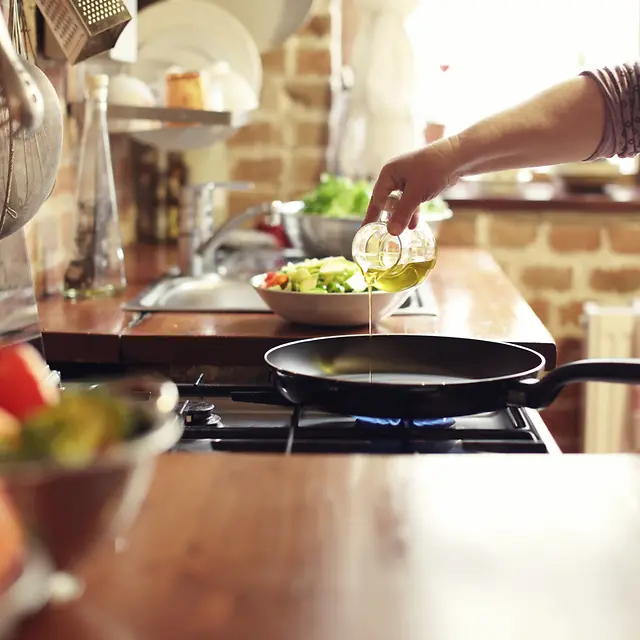When we eat, we encounter fat in many forms. We use butter for frying, olive oil in salads and “hidden” fat is also added to many foods. Although fat is essential for our organism, not all fats and oils are equally suitable for a healthy diet: it all depends on the quantity consumed and the quality.
Healthy fats: Why is fat important for the body?
Fats (lipids) and their building blocks, fatty acids, are vital for the human body:
- They provide more than twice as many calories as carbohydrates and proteins and are therefore important sources of energy.
- They fill you up well.
- Fat serves as an energy store for the body, for example by being stored in the tissue.
- Fat serves as a transport medium for the fat-soluble vitamins A, D, E, K.
- Polyunsaturated fatty acids contribute, among other things, to the formation of hormones.
- Lipids often contain relevant amounts of vitamin E.
- Native, cold-pressed oils contain valuable secondary plant substances (especially beta-carotene and lutein).
- Many unsaturated fatty acids have a positive effect on blood lipid levels and blood pressure.
Because fat is also a natural flavor enhancer, we usually find high-fat foods really tasty. However, which fats we eat play a role in a healthy diet.
Are there healthy and unhealthy fats?
Fats consist of different fatty acids:
- Saturated fatty acids
- Monounsaturated fatty acids
- Polyunsaturated fatty acids
Certain fatty acids are more valuable for our body than others and are therefore often referred to as good fats.
Some unsaturated fatty acids are essential. This means that the body cannot produce this good fat itself, but has to get it through food. These include the omega-3 fatty acid alpha-linolenic acid and linoleic acid.
Omega-3 fatty acids also serve as a starting material for hormone-like substances, so-called eicosanoids, which significantly reduce the risk of cardiovascular diseases.
Too high a level of saturated fatty acids, on the other hand, is said to have a negative impact on blood lipid levels. Saturated fatty acids are therefore not considered unhealthy or bad, but experts recommend reducing their intake. Instead of animal fats with a lot of saturated fatty acids, it is best to choose plant foods with a high proportion of unsaturated fatty acids, especially monounsaturated oleic acid and polyunsaturated omega-3 fatty acids.
It’s not just the blood lipid levels that benefit: an analysis of the results of 15 studies showed that the risk of heart and vascular problems is reduced when saturated fatty acids are replaced with polyunsaturated fatty acids.
Like omega-3 fatty acids, omega-6 fatty acids are essential and must therefore be consumed with food. However, they are also used by the body to produce inflammatory hormones, while omega-3 fatty acids are used to produce anti-inflammatory messenger substances. In order to optimally balance these effects, the ratio of omega-3 to omega-6 fatty acids is important: it should be at least 5:1. Rapeseed, walnut, soybean, olive and linseed oil have a favorable composition in this regard. So it’s worth using these oils or spreadable fats made from them more often in the kitchen.
Healthy oils: When is which oil suitable?
Cooking oils can be distinguished based on their production process, which also influences the optimal use of the oils in the kitchen:
Cold-pressed oils for cold cuisine : Native, cold-pressed oils are produced particularly gently. This not only preserves the typical taste, but also vitamins and secondary plant substances, which are said to have various health-promoting effects. Cold-pressed oils with a high proportion of polyunsaturated fatty acids – such as native linseed oil – should not be heated as they have a low smoke point and vitamins and secondary plant substances can otherwise be lost. Cold-pressed oils, such as virgin rapeseed oil or olive oil, are ideal for cold cooking, for example in salad dressings.
Refined oils for frying and deep-frying : Heat and chemical processes are used to produce refined oils. As a result, secondary plant substances, vitamins and unsaturated fats are partially lost. These oils usually have less flavor than cold-pressed oils and can also be heated to high temperatures: they are ideal for cooking, frying and deep-frying. Examples include refined rapeseed or sunflower oil.
Lipids should not be overheated. If they start smoking (smoke point), they decompose and harmful substances are produced. Different fat sources have different smoke points. For example, virgin olive oil cannot be heated as much (smoke point at 130-180°C) as refined rapeseed oil (218°C) or sunflower oil (209°C). The latter are therefore ideal for frying. Fat should also not be heated multiple times, otherwise compounds that are undesirable to health can form.
Healthy oils at a glance
rapeseed oil
Rapeseed oil consists largely of monounsaturated oleic acid and polyunsaturated fatty acids. Both have a particularly beneficial effect on cardiovascular risk. Rapeseed oil also contains vitamin E and is characterized by a particularly favorable ratio of omega-3 to omega-6 fatty acids.
The German Nutrition Society (DGE) describes rapeseed oil as the oil of choice due to its numerous positive properties.
olive oil
Olive oil has a high proportion of oleic acid, which, along with omega-3 fatty acids, can protect against cardiovascular diseases.
sunflower oil
Sunflower oil contains a particularly high amount of linoleic acid, a polyunsaturated fatty acid.
linseed oil
Flaxseed oil is a good source of unsaturated fatty acids, especially alpha-linolenic acid. However, linseed oil can quickly taste rancid and is best stored in a cool place away from light.
Walnut oil
Walnut oil scores with a particularly favorable ratio of omega-3 to omega-6 fatty acids.
Coconut oil
Coconut oil or coconut fat is solid or liquid depending on the storage temperature. Like palm fat, which is found in many processed products, it has a high proportion of saturated fatty acids and should therefore – as explained above – only be enjoyed in moderation.
How fish differs from other animal fat sources
Animal foods such as meat, milk and dairy products mainly provide saturated fats. Things are different with fish: it contains the polyunsaturated fatty acids eicosapentaenoic acid and docosahexaenoic acid. These are also found in low-fat fish such as redfish, cod, hake or plaice. However, significant quantities are primarily consumed through fatty sea fish such as salmon, mackerel or herring.
The DGE recommends one to two portions of fish per week, including 70 grams of fatty sea fish.
Hidden fat and trans fatty acids
Fat provides a lot of calories and therefore serves as an important source of energy in our diet. According to the DGE , it should only make up around a third of your daily calorie intake, while the remaining calorie requirements are covered by carbohydrates and proteins. However, many people eat far more fat than recommended every day. If the body cannot use it up, it migrates directly into the body’s own fat cells – or to put it another way: you gain weight.
In order not to unknowingly eat too much, it is better to keep an eye on the “hidden” sources of fat that are found in many foods:
- Sausage
- Meat
- pastries
- Fried foods
- sauces
- crisps
- sweets
- ready meals
- Fast food
Tip: If you cook yourself and do meal prep , you can not only determine the fat content of the food yourself, but also the quality of the fat (e.g. by replacing animal fats with vegetable fats such as rapeseed oil.e.g. B. by replacing animal fats with the use of vegetable fats such as rapeseed oil.
Beware of trans fats
Trans fatty acids are unsaturated fatty acids. They are structurally similar to saturated fatty acids and can have an unfavorable effect on blood lipid levels. This is why these “bad” fats play a role in the development of diseases such as heart attacks or strokes. Unhealthy fatty acids can often be avoided when cooking because high temperatures change the structure of lipids. The decisive factors are the duration and temperature. Vegetable oils with a high content of unsaturated fatty acids can be converted into trans fatty acids at temperatures starting at 130 degrees. Therefore, vegetable oil is not suitable for frying.
Trans fats are also created when originally healthy vegetable oil is industrially hardened. But they are also found naturally in some foods, such as butter.
Trans fatty acids can also be found in the following foods:
- margarine
- frying fat
- Frying fat
- ready meals
- Bakery products
- sweets
Many manufacturers have now significantly reduced or completely removed trans fats from their products. The Federal Institute for Risk Assessment (BfR) considers the current level of trans fat intake in Germany to be harmless to health. Those who avoid hidden fat usually also keep their trans fat intake low.

